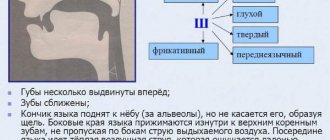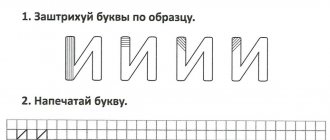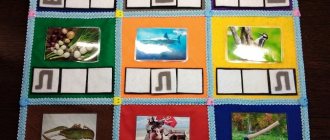Games for determining the place of sound in a word.
Games for determining the place of sound in a word
CHAIN OF WORDS
Task:
Exercise children in identifying the first and last sounds in words.
Equipment:
cards with subject pictures.
Progress of the game
4-6 children play. Each child has 6 cards. The teacher begins to lay out the chain. The next picture is placed by a child whose name of the depicted object begins with the sound that ends with the word - the name of the first object. The winner is the one who lays out all his cards first.
FIND THE PLACE OF THE SOUND IN THE WORD
Task:
Exercise children in finding the place of sound in a word.
Equipment:
cards with diagrams of the location of sounds in words.
Progress of the game
Each child receives a card. The teacher shows pictures and names words. If a given sound is heard at the beginning of a word, you need to place a chip in the first cell. If a sound is heard in the middle of a word, the chip must be placed in the second cell. If the sound is at the end of the word, the chip is placed in the third cell. The winner is the one who made no mistakes.
MATCH THE WORD TO THE DIAGRAM
Task:
Exercise children in finding the place of sound in a word.
Equipment:
cards with diagrams of the location of sounds in words.
Progress of the game
Having received a card, the child selects 3 pictures (words with a given sound), focusing on the shaded square.
FIND A PAIR
Task:
Exercise children in selecting words that differ from each other by one sound. Develop phonemic awareness.
Equipment:
sound clock, a set of subject pictures, words - paronyms.
Progress of the game
The teacher places 6 pictures on the clock. For example, scythe - bark, com-dom, poppy - cancer. Children are asked to find pictures with objects whose names sound similar and differ only in one sound. Which one? The child who first found these words moves the arrows to the pictures. Children find all three pairs of words. The game can be repeated by replacing the pictures with new pairs (barrel-kidney, car-dacha, T-shirt-seagull).
TURN ON TV
Task:
exercise children in determining the first or last sound in words, in composing words from highlighted sounds, and practice reading words (as a complicated version).
Equipment:
manual “TV”, subject pictures and cards with letters, pictures for the TV screen.
Progress of the game
The teacher explains to the children that in order to turn on our TV and see the image on its screen, they need to identify the first sound in the words-names of objects placed in the top pocket. With these sounds you will create a new word. If the word is spelled correctly, the corresponding item will appear on the screen.
For example: matryoshka, stork, cat - MAC. The “poppy” picture appears on the screen.
The highlighted sound can be designated by the corresponding letter and read.
HOUSES
Task:
develop the ability to differentiate similar sounds, find the place of a sound in a word.
Equipment:
a set of subject pictures whose names begin with oppositional sounds, 2 houses, each house has 3 pockets (beginning, middle, end of the word).
Progress of the game
The child takes a picture, names it, determines the presence of a sound (for example; [Ч] or [Ш']), its place in the word, inserts the picture into the appropriate pocket. Points are awarded for correctly completed tasks.
FISHERMAN
Task:
develop the ability to establish the place of sound in a word.
Equipment:
small subject pictures with a metal clip, a fishing rod, cards - diagrams (beginning, middle, end of the word) for each child.
Progress of the game
“Catch” the word, determine the place of the sound in the word and place the picture in the appropriate box. Children take turns performing actions.
PUNCH CARD GAME
“COVER THE WINDOW WHERE THE SOUND LIVES”
Task:
learn to determine the place of a sound in a word (beginning, middle, end of a word) by representation.
Equipment:
punch card folders in which three pictures are placed, holes are cut out under each - “windows” for sounds. In the right corner of the punch card there is an image of a letter.
Progress of the game
Several people play, no more than punch cards. The players take one punched card each and, focusing on the letter, determine the place of the corresponding sound in the name of each picture: they find for each sound its “apartment in a house consisting of three apartment-holes.” The found place is painted over. The presenter checks the correctness of the task and allows you to take the next punched card. The winner is the one who correctly analyzed the largest number of punched cards.
“EACH SOUND HAS ITS OWN ROOM”
Task:
teach how to conduct a complete sound analysis of a word based on the sound diagram and chips.
Progress of the game
Players receive houses with the same number of windows. Residents - “words” - must move into the houses, and each sound wants to live in a separate room. Children count the number of windows in the house and conclude how many sounds there should be in a word. Then the presenter pronounces the word, and the players name each sound separately and place the chips on the windows of the house - “populate the sounds.” At the beginning of training, the leader says only words suitable for settling in, that is, those that will contain as many sounds as there are windows in the house. At subsequent stages, you can say a word that cannot be “settled” in a given house, and the children, through analysis, are convinced of the mistake. Such a tenant is sent to live on another street, where words with a different number of sounds live.
“HOW MANY ROOMS IN THE APARTMENT?”
Task:
teach how to determine the number of sounds in words without relying on a ready-made diagram using chips.
Progress of the game
For the game, word houses are used, but without diagram windows. Each player has one such house, as well as several chips and a set of numbers: 3, 4, 5, 6. The teacher has object pictures. He shows a picture, the children place window chips in the house according to the number of sounds, and then put the corresponding number. Then the chips are removed from the house, the presenter shows the next picture, and the children analyze the word again. At the end of the game, relying on the numbers, you need to try to remember which pictures were offered for analysis. You can ask them to choose their own words with the same number of sounds.
"LONG AND SHORT WORDS"
Task:
teach how to determine the number of sounds in words using auxiliary means.
Progress of the game
The teacher pronounces the word out loud, and the child calls it by its sounds and at the same time releases the windows of the sound ruler. Then he counts the number of boxes and answers how many sounds there are in a given word. It also analyzes the next word and concludes which word is longer and which is shorter.
"BUILDERS"
Task:
teach to determine the number of sounds in words perceived by ear.
Progress of the game
Children have several houses with different numbers of windows. The teacher creates a game situation: “Imagine that you are builders and now you will build a street for words. Each house is for a separate word. But words will want to live in houses in which each sound will have a separate room with one window. I will now name the words, these are the future residents of our street, and you lay out the necessary houses in one row from left to right. At the end of the game, someone will remember what kind of tenants we are waiting for in our houses.” Then the teacher pronounces out loud words consisting of three, four, five and six sounds, and the children lay out the houses in one row. After this, one child names the words from memory, based on the house diagrams. You can ask to name other words with the same number of sounds, that is, to invite guests to a housewarming party.
Approximate speech material for the game: crayfish, dog, cat, fly, rooster, cow, carp, magpie, ox, giraffe.
"HOWWARMING PARTY AT THE BEASTS"
Task:
teach to determine the number of sounds in words spoken aloud by the child himself.
Progress of the game
Children have pictures of various animals. The teacher shows the houses, and the children choose the right houses for their animals. At the same time, they say the word out loud, then each sound separately, count the number of sounds and ask for a house with the same number of windows.
“WHO WILL BE INVITED TO VISIT”
Task:
teach to determine the number of sounds in words pronounced out loud by the child himself.
Progress of the game
Four people play, each player has a house. On the table there are subject pictures with images of various animals (according to the number of players), as well as a stack of cards with the images down. Children choose the pictures they need from those that lie face up - “find the owner of the house.” Then everyone, in turn, takes one picture card from the pile, says the word out loud and determines whether they should “invite this picture to your house for a visit or not.” If the word - the name of the picture opened by the child - has the same number of sounds as the word - “host”, then you need to invite them to visit, and then the player gets the right to make additional moves until an unsuitable picture is encountered. If the number of sounds is different, the picture is placed at the end of the stack. The winner is the one who called all his guests first. One set includes four pictures with each number of sounds.
Approximate picture material for the game: pictures - “owners”: cat, wolf, wild boar, dog; pictures - “guests”: three sounds - wasp, catfish, beetle, crayfish; four sounds - goat, owl, beaver, mole; five sounds - jackdaw, giraffe, marmot, bear; six sounds - cow, chicken, rabbit, crow.
“WHO WILL Settle WHERE”
Task:
teach how to determine the number of sounds by presentation.
Progress of the game
Houses are laid out on the table in a random order in the form of a street, and under them in the second row are all the pictures for populating the houses. The players take turns throwing the dice and taking the correct picture according to the score. This picture needs to be placed next to the house with the same number of sounds as in the word - the name of the picture.
For the game, houses and pictures are selected that correspond to each other in the number of sounds, so that there is enough houses for everyone, and one picture can live in each house.
“WHO IS THE APARTMENT NOT SUITABLE FOR?”
Task:
teach how to determine the number of sounds by presentation.
Progress of the game
The game is played in the same way as the previous one, only one extra picture is given. It is found during the game or identified immediately and put aside. An inappropriate picture needs to be changed so that interest in this game moment is maintained each time.
"TELEGRAPHISTS"
Task:
developing skills of consistent sound analysis based on presentation; training in sound synthesis of words.
Progress of the game
Two children are playing; they are telegraph operators, sending and receiving telegrams. The content of the telegram is set by the teacher, who, secretly from the second player, shows the first player a picture. He must “convey the contents of the telegram”: pronounce the word - the name of the picture by sound. The second player “receives the telegram” - calls the word together, that is, carries out the operation of sound synthesis. Then the players change roles and the game continues.
"CATCH THE SOUND"
Task:
teach to name the sound in a word according to its spatial characteristics (first, second, after a certain sound, before a certain sound).
Progress of the game
Children stand in a circle, the teacher has a ball. He pronounces a word out loud, throws a ball to anyone playing and says what sound he should name, for example: “Cheese, second sound.” The child catches the ball, answers: “Y” - and returns the ball to the presenter, who asks the next task related to the same word. All sounds in a word must be analyzed, and several tasks can be presented for the same sound.
“MATCH A PICTURE TO THE DIAGRAM”
Task:
teach to determine the place of a sound in a word (beginning, middle, end) by representation.
Progress of the game
Children have diagrams of words (rectangles divided crosswise into three parts, with the first part colored - the beginning of the word, the second part colored - the middle of the word, the third part colored - the end of the word). Before the game, each participant chooses a letter from those offered. The teacher shows pictures (a letter is placed in the upper right corner of each picture), and the children must ask for those that contain the sound they have chosen, and put these pictures to the desired diagram. The winner is the one who first collects three pictures for each scheme. Then the children change letters and the game continues.
"COLLECT THREE"
Task:
consolidate the ability to find the place of a given sound in a word by representation.
Progress of the game
The game uses pictures and diagrams from the previous game “Match the picture to the diagram.” Pictures are distributed to children, and diagrams are laid out on the table. The teacher shows the letter, and children who have pictures whose names contain the corresponding sound must attach them to the diagrams. There should be three pictures under each diagram. Then these pictures are removed, and the teacher shows the next letter. It may happen that not all participants in the game will be able to make the right move on their own; If a child puts in the wrong picture, the mistake is pointed out to him, the picture is returned back and a penalty chip is given. If someone misses the opportunity to post the desired picture, he is not informed about this, and at the end of the game it is calculated who missed how many moves. For each unposted picture, one penalty point is also awarded. The one who receives fewer penalty points wins.
"SOUND LINE"
Task:
learn to determine the sequence of sounds in a word, highlight each sound.
Equipment:
sound line.
Progress of the game
The teacher demonstrates to the whole group the sequence of sounds in a word, moving the circle - the sound in the ruler from one window to another, and the children carefully look at the ruler and pronounce the sounds of the word. In the future, children learn to work with a ruler independently.
"SOUND MOSAIC"
Task:
learn to identify the first sound in words.
Equipment:
multi-colored square tokens 3x3 cm. Sheets with drawn grids 3x3, 4x4, 5x5, Squares on sheets of the same size as the tokens.
Progress of the game
The teacher names different words. If the words begin with a sound:
[k], [k'] - put a red token,
[s], [s'] - blue token,
[zh] - yellow token,
[z], [z'] - green token,
[h'] - black token.
“LIVING SOUNDS, SYLLABLES”
Task:
learn to synthesize individual sounds (syllables) into a word.
Progress of the game
We call the children and tell them who will turn into what sound. For example:
- Misha, you are turning into the first sound, the word “donut”.
- Katya, you are becoming the last sound of the word “mol.”
- Olya, you are the main sound “and”.
— Vera, you are the second sound of the word “bottom”
Children line up. They hold circles in their hands that match their sound (blue, red or green). Children have a “living” model of the word in front of them. Children-sounds name each sound. The rest can guess what word it turned out to be.
"TIM AND TOM"
Task:
learn to differentiate hard and soft sounds.
Progress of the game
2 people Tim and Tom: soft and hard - small and large. Tom always chooses objects that begin with hard sounds, or in which the given sound is hard. Tim - prefers everything that starts with a soft sound.
Games
"Tom and Tim Go on a Road Trip"
"Tom and Tim in the Forest"
“Tom and Tim play words (syllables) - words that differ only in one sound (nose-carry, bow-luk)” (You can play with a ball.)
Phonetic analysis - what is it?
In linguistics and related disciplines, phonetic analysis is usually called the direct determination of the sound composition of a word. Simply put, it is a breakdown of sounds and letters.
To designate a particular sound, transcription is used - certain designations of sounds that are enclosed in square brackets. The Russian language uses Cyrillic transcription. This has happened historically and it has become a generally accepted practice. An alternative system based on universal type designations has taken root extremely poorly and is practically not used, with rare exceptions. From time to time you may come across variants of transcriptions using the Latin alphabet, for example [th"] transcribed as [j], but this is rather rare.
A number of Cyrillic characters for transcription are not used in principle. For example: hard sign, soft sign, ё, ya and some others. The softness of a consonant is highlighted by the [“] sign. The accent is indicated on top of the vowel or by a separate bracket if spelling is used.
What is the procedure for phonetic word parsing and what does it look like?
Phonetic parsing of a word is carried out according to the following algorithm:
- First, the word is divided into individual syllables and the stress is indicated.
- A transcription of all sounds individually and the entire word is recorded.
- For each sound, a characteristic is determined: for vowels it is stressed or unstressed, for consonants it is hard or soft, voiced or dull. Pairing of sound.
- The number of letters and sounds is calculated mathematically.
The phonetic component of a language includes a number of constituent elements, representing a specialized branch of linguistics. In this article we will just briefly familiarize ourselves with phonetics, its basic concepts and rules. A more thorough delving into phonetics will require you to become familiar with specialized literature and a serious investment of time resources.






